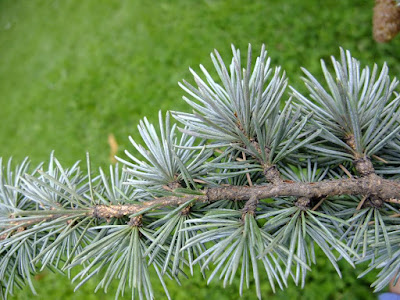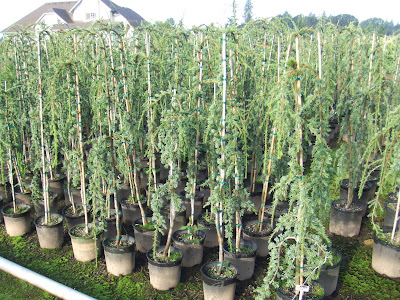| General Information |
| Common Name | Atlas Cedar |
| Scientific Name | Cedrus atlantica |
| Sun Tolerance | Full Sun |
| Height | 30 - 35 m (100 - 118 ft) |
| Spread | 15 -20 m (50 - 66 ft) |
| Growth Rate | Fast |
| Bloom Time | Spring |
| Color | Green, |
| Flower Color | Yellow |
| Type | Tree |
| Native | Africa, Asia, Europe. |
|
|
| Classification |
| Kingdom | Plantae – Plants |
| Subkingdom | Tracheobionta – Vascular plants |
| Superdivision | Spermatophyta – Seed plants |
| Division | Coniferophyta – Conifers |
| Class | Pinopsida |
| Subclass |
|
| Order | Pinales |
| Family | Pinaceae – Pine family |
| Genus | Cedrus Carr. – Cedar |
| Species | C. atlantica |
|
|
 |
| Cedrus atlantica - Atlas Cedar |
Cedrus atlantica commonly known as Atlas Cedar. The tree’s
native habitat is on the mountains of Algeria and Morocco. It is a large
growing evergreen tree that grows 30-35 m (100 – 118 ft) in height with a trunk
diameter of 1.5–2 m (5-7 ft). Sometime it grows up to 40 m (131 ft) in height.
The Atlas Cedar differs principally from other Cedars in
having an erect leader and ascending ends to the branches. Furthermore, it has
a blue-green foliage, and may even be grey; and the cones are usually more
numerous and rather smaller and less barrel-shaped.
The trees are conical when young, later developing massive trunks
and large, ascending branches. The branch-lets are of two kinds; the long
terminal growth shoots with needles scattered around them (‘juvenile’ foliage),
and short spur growths with needles in rosettes. The mature needles are about
an inch in length, and slightly bluish-green.
Both sexes of flowers are usually found on different
branches of the same tree. The male catkins, in regimented rows, are long and
erect, dull greyish-green with a purplish bloom, liberating bright yellow
pollen in autumn. The females are small, greenish, erect cone-lets, and the
resultant erect resinous barrel-shaped green cones do not reach full size until
after two years, when they turn brown and ripen within a few months. They then
gradually break up, releasing their winged seeds, the central spike of the cne
alone remaining.
At first the bark is smooth and grey, but with age becomes
brown, furrowed and scaly. The wood has a narrow whitish sapwood and a
mid-brown heartwood, and is fairly hard, fragrant, naturally durable, and will
work to a fine finish. It is scarce, hence little used commercially.


























